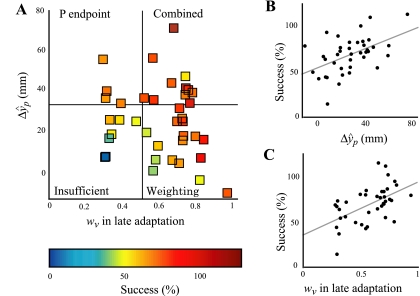Fig. 5.
wV and ΔŷP are each related to success in experiment 1. A: each square represents a single subject. Color reflects success. Subjects who rely heavily on vision are not more or less inclined to shift P reach endpoints in the direction of the perturbation (no significant correlation between wV and ΔŷP: r = −0.15, P = 0.37, n = 39 subjects). Subjects could succeed at the task by shifting P endpoints in the direction of the misalignment (ΔŷP, reflecting some combination of proprioceptive realignment and motor adaptation), weighting vision high, or both. Together, wV and ΔŷP account for 62% of the variance in success (stepwise multiple regression R2 = 0.62, F = 29.3, P < 0.0001). B: ΔŷP is related to success for subjects in experiment 1 (r = 0.49, P = 0.0014). C: wV is related to success for subjects in experiment 1 (r = 0.53, P = 0.0005). Overall, these results suggest P endpoint and weighting strategies operate independently in this task and, furthermore, that either strategy can lead to success at hitting targets. This implies greater behavioral flexibility than if only one strategy led to success.

